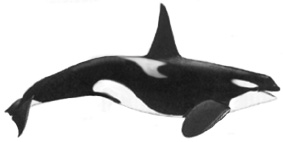|
KILLER
WHALE |
|

|
|
SCIENTIFIC
NAME
- Orcinus
orca from the greek oryx, orygos "tearing up", or
from the latin orca "pot-bellied vase".
|
|
FAMILY
- Delphinidae
|
| DIMENSIONS
- It's the largest dolphin, the female is smaller of the
male, medium length 7 mt, maximum 10 mt, medium weight 5 t
8 t. |
| ASPECT
- Massive Body; rounded head; melon proportioned
and shortest rostrum; protruding jaw regarding the jaw; large or
very large dorsal fin, arcuated (in the females), with rectilinear or
arcuated apex in ahead (males); fins large and rounded. |
| SKIN
and COLORATION - Black (back) and white (abdomen until to genital
zone), temporal spot white, grey strip behind dorsal fin (called
saddleback), inferior side of the tail white. |
| LONGEVITY
- Fino a 50 anni. |
| REPRODUCTION
- The reproduction is not easy
uniformabile to outlines given to the variety of the social
relationships own of the killer whales (in kind spring beginning summer). The
varied gestation from 12 to 16 months. To the birth puppy measure approximately 2 mt and hung approximately 180 Kg. |
| TEETH
- Medium 48, large and conical, 3 cm of diameter. |
| BREATH
= Little visible. |
|
SOUNDS
- Three types of emissions:
1° click, used
emissions of short duration for the biosonar.
2° it hisses modulated.
3° sounds to impulses.
The emissions of the number 2 and 3 constitute the dictionary of the killer whale, used in order to communicate
and a lot different from one zone to an other.
|
| FEEDING
- The diet of
the killer whale is most varied, all the eatable marine organisms are its
potential preys. Fish and squids but also of cetaceans of enormous
dimensions like the Finners, turtles, pinnipedi etc. All that in
order to satisfy requirementses that are gone around on the 200 Kg of
food the day. The predatory techniques of the killer whale are several;
in shoal or alone; to great depths until -1000 mt or quite on the
waves near on the beach (Vd. Feeding). |
| HABITAT
- Cetaceo presente in tutti i mari in cui il cibo sia
sufficiente, in alto mare come lungo le coste, in mari freddi come
tropicali. |
| SWIM
- It's one of the
faster cetaceans it swims in fact to approximately 50 Km/h (27 nodes).
Sometimes they emerge with the head for looking around (spyhopping) or
slap the sea with the tail (tailslapping). |
| JUMPS
- They
carry out spectacular jumps with the total emersion of the body
from the water. |
|
MIGRATIONS
- Exist stantial groups and others that
complete migrations above all in polar waters.
|
|
SOCIALITY
- Strongest
and complex social ties that are found also in the techniques of
hunting in shoal. The social organization is variable draft in fact
of a cetacean socially very adaptable.
|
|
TEMPERAMENT
- Very intelligent and
unforeseeable one, is not documented attacks to the man to predatory fine in some cases has attacked small boats.
|
|
DANGER
and PREDATORY
- No predator, very rarely victim of beachings.
|
|
SPECIES
DIFFUSION
- Odontocet diffuse geographically in
all the waters of the world guesstimates estimates in 200,000
approximately the total number. In the Mediterranean they penetrate
sporadically for predatory incursions.
|
|

|